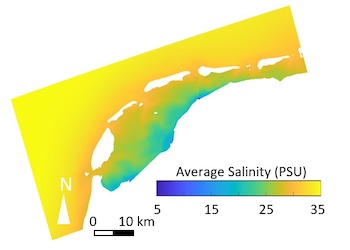C. Donatelli1*, J.F. Urbina2, M. Duran-Matute2, U. Gräwe3, T. Gerkema1
1 NIOZ,
2 Eindhoven University of Technology,
3 Leibniz-Institute for Baltic Sea Research,
Two major agents in the movements of water and sediment in the Dutch Wadden Sea (DWS) are the tides and the wind. While the former is highly predictable, the latter is episodic in nature; the wind climate varies even strongly from year to year, and was previously shown to have a disproportionately large effect on the dynamics of the DWS. In the recently started LOCO-EX project, we use a 35-year long numerical simulation to study the hydrodynamics of the DWS from the perspective of an event-driven system. In this presentation, we first focus on salinity variability. In particular, we employ advanced statistical methods to detect events characterized by extreme salinity values since these episodes dramatically increase stress levels on organisms living in intertidal areas. In the second part of this talk, we analyze the system from a Lagrangian point of view to study the spatio-temporal variability of the transport time scales under different wind conditions. We focus especially on the residence time, in order to examine Lagrangian retention and episodes of strong flushing events between the DWS and its surroundings.

Figure: Long-term mean salinity distribution in the Dutch Wadden Sea.
I. Surname1*, F.N. Another-Surname2 , Y. Next-Surname2
1 University Name, Country; 2 Organization Name, Country
* Corresponding author: mail.name@organization.org


